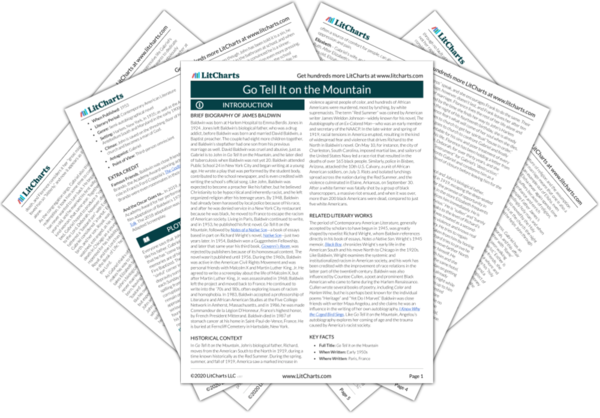Faith and Religion
Religion is at the center of James Baldwin’s semiautobiographical novel, Go Tell It on the Mountain. The book’s title is a reference to a popular African American spiritual song about the birth of Jesus, and many of Baldwin’s characters carry biblical connotations and parallels. The novel follows protagonist John—so named for Saint John the Baptist—and his evolution from an adolescent sinner to a saved man of God. Like the Christian Bible, which includes…
read analysis of Faith and ReligionSex and Morality
As Go Tell It on the Mountain focuses on God and religion, it also examines sin and morality, and sex and sin go hand in hand in Baldwin’s novel. The Old Testament identifies “fornication,” or sex outside of marriage, as a direct sin against God, and this belief is reflected throughout Go Tell It on the Mountain. Sex is a constant threat to the morality of Baldwin’s characters, and those who partake in sex…
read analysis of Sex and MoralityRace and Racism
James Baldwin’s Go Tell It on the Mountain is set in Harlem in 1935, some twenty years into America’s Great Migration. After the Civil War and the end of slavery in 1865, the country entered the Reconstruction Era, in which African Americans were finally afforded freedom and equality under the constitution. In practice, though, people of color continued to be treated with widespread discrimination, exploitation, and abuse, especially in the South—thus began the Great Migration…
read analysis of Race and Racism
Gender, the Patriarchy, and Misogyny
Traditional gender roles are clearly defined from the very beginning of James Baldwin’s Go Tell It on the Mountain. When John attends his Harlem church on Sunday mornings, “the women all seem patient,” and “all the men seem mighty.” Women are considered fragile and dependent upon men, and the men who head the patriarchal families are often cruel and abusive. According to Florence, John’s aunt, “ain’t no woman born that don’t get walked…
read analysis of Gender, the Patriarchy, and Misogyny






